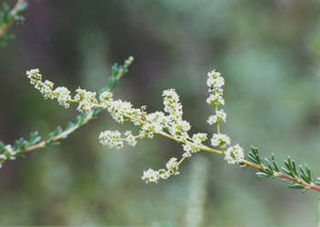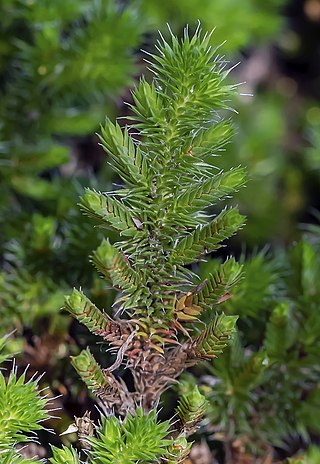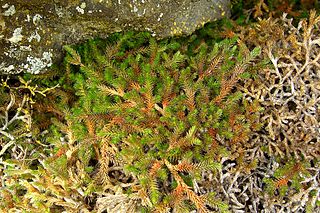
Selaginella is the sole genus in the family Selaginellaceae, the spikemosses or lesser clubmosses, a kind of vascular plant.

A perennial plant or simply perennial is a plant that lives more than two years. The term is often used to differentiate a plant from shorter-lived annuals and biennials. The term is also widely used to distinguish plants with little or no woody growth from trees and shrubs, which are also technically perennials.

Adenostoma fasciculatum, commonly known as chamise or greasewood, is a flowering plant native to California and Baja California. This shrub is one of the most widespread plants of the California chaparral ecoregion. Chamise produces a specialized lignotuber underground and at the base of the stem, known as a burl, that allow it to resprout after fire has off burned its stems. It is noted for its greasy, resinous foliage, and its status as one of California's most iconic chaparral shrubs.

Selaginella lepidophylla is a species of desert plant in the spikemoss family (Selaginellaceae). Known as a "resurrection plant", S. lepidophylla is renowned for its ability to survive almost complete desiccation. Resurrection plants are vascular rooted plants capable of surviving extreme desiccation, then resuming normal metabolic activity upon rehydration. The plant's hydro-responsive movements are governed by stem moisture content, tissue properties and a graded distribution of lignified cells affecting concentric stem stiffness and spiraling. During dry weather in its native habitat, its stems curl into a tight ball, uncurling only when exposed to moisture.

Malosma is a plant genus which contains only a single species, Malosma laurina, with the common names laurel sumac and lentisco (Spanish). Malosma laurina is found along the southern California and Baja California coasts of the Pacific Ocean.

Allium platycaule is a species of wild onion known as broadstemmed onion or flat-stem onion. It is native to northeastern California, south-central Oregon and northwestern Nevada. It is found on slopes of elevations of 1500–2500 m.

Selaginella selaginoides is a non-flowering plant of the spikemoss genus Selaginella with a wide distribution around the Northern Hemisphere. It resembles a moss in appearance but is a vascular plant belonging to the division Lycopodiophyta. It has a number of common names including lesser clubmoss, club spikemoss, northern spikemoss, low spikemoss and prickly mountain-moss. This plant has one close relative, Selaginella deflexa, native to Hawaii. These two plants form a small clade that is sister to all other Selaginella species.
Selaginella asprella is a species of spikemoss known by the common name bluish spikemoss. It is native to California and Baja California, where it has a disjunct distribution, occurring in the Klamath Mountains and mountain ranges several hundred miles to the south. It grows in rocky mountainous habitat, on cliffs of limestone rock substrate, and on forest ridges. This lycophyte grows in flat mats with many short, forking stems twisted together. The stems fragment easily, especially as they dry. The lance-shaped green leaves are up to 5 or 6 millimeters long, including the soft bristles at their tips. The leaves are alike in shape and borne in squarish whorls of four about the stem. They are flattened to the stem.

Selaginella bigelovii is a species of spikemoss known by the common names bushy spikemoss and Bigelow's spikemoss. It is native to California and Baja California, where it grows in rocky places in many different habitat types, from the coastline to the mountains to the deserts. This lycophyte forms clumps of spreading upright to erect stems up to 20 centimeters long with a few short lateral branches. The linear or lance-shaped green leaves are up to 4 millimeters long, including the tiny rigid bristles at their tips. They are flattened to the stem or stick out just a little. The strobili borne at the leaf bases are yellow-orange in color.

Selaginella cinerascens is a species of spikemoss known by the common names mesa spikemoss, gray spikemoss, and ashy spikemoss. It is native to Baja California as well as some locations just north of the border in San Diego County, California. It grows in dry habitat, often on clay soil, both in open areas and in the shade of larger plants. This lycophyte forms mats of spreading, forking stems up to 18 centimeters long. The plant is often gray or brown in color, forming a dull-colored carpet on the substrate. The linear or lance-shaped leaves are 1 to 3 millimeters long and lack bristles at the tips. The leaves are green when new or moist. They are flattened to the stem or stick out just a little. The strobili borne at the leaf bases are yellow in color and no more than 4 to 5 millimeters long.

Selaginella densa is a species of spikemoss known by the common names lesser spikemoss, prairie spikemoss, and Rocky Mountains spikemoss. It is native to western North America, where it can be found from Alaska to Ontario, the Dakotas, Texas and far northern California.

Selaginella hansenii is a species of spikemoss known by the common name Hansen's spikemoss. It is endemic to California where it can be found throughout the central part of the state, from the lowest reaches of the Cascade Range through the Central Coast Ranges and Sierra Nevada to the southern end of the Central Valley and the Tehachapis. It can be found in varied rocky habitat in hills and mountains. This lycophyte forms loose or dense mats of spreading stems with small, forking branches. The lance-shaped or triangular leaves are up to 5 or 6 millimeters long including the soft, white bristles at the tips. The leaves are green, often tinged with red, or totally red. The strobili containing the reproductive structures are under a centimeter long.

Selaginella oregana is a species of spikemoss known by the common name Oregon spikemoss. It is native to the Pacific Coast of western North America, where it can be found from British Columbia to northern California. It grows in mossy, shady coastal forests. It is often epiphytic, growing attached to tree branches, its stems hanging in sheets of green, mosslike streamers. Trees commonly occupied by the spikemoss include bigleaf maple, black cottonwood, and red alder. It also grows on the ground and on rocks in carpetlike mats. This lycophyte has creeping or hanging stems up to about 60 centimeters long, usually with forking branches. They curl as they dry. The stems are radially symmetric, with spirals of lance-shaped leaves each measuring 2 or 3 millimeters in length and tipped with a tiny, rigid bristle. The strobili containing the reproductive structures are up to 6 centimeters long and often occur in pairs.

Selaginella wallacei is a species of spikemoss known by the common name Wallace's spikemoss. It is native to western North America from British Columbia to California to Montana, where it can be found in many types of habitat, including open and shaded areas, and wet to dry environments, often growing on and over rocks. This lycophyte is variable in appearance, its form depending on the habitat it grows in. It can be spreading with many narrow branches, or a small, dense mat. The forking stems grow up to about 25 centimeters long, but may remain much shorter in dry conditions. They are lined with linear, lance-shaped, or oblong leaves up to 4 millimeters long including the bristles at the tips. The strobili containing the reproductive structures may be quite long, reaching up to 9 centimeters.
Selaginella watsonii is a species of spikemoss known by the common name Watson's spikemoss. It is native to the western United States, where it grows in many rocky habitat types, including high mountain peaks in alpine climates. This lycophyte forms mats or cushions of short, forking stems. They are lined with linear or lance-shaped leaves no more than 4 millimeters long, often tipped with tiny bristles. The strobili containing the reproductive structures are 1 to 3 centimeters long.
Sedum moraniii is a rare species of flowering plant in the family Crassulaceae known by the common name Rogue River stonecrop. It is endemic to Oregon in the United States, where it only grows in Josephine County next to the Rogue River.

Selaginella denticulata, or Mediterranean clubmoss, is a non-flowering plant of the spikemoss genus Selaginella with a wide distribution around the Northern Hemisphere.
Selaginella stellata, also recognized by its common name, starry spikemoss or starry spike-moss, is a species of spikemoss of the family Selaginellaceae. It is a type of lycopod that grows naturally in Mexico and Central American countries like Guatemala and Belize and can also be found in the state of Hawaii.
Selaginella sibirica, the Siberian spikemoss, is a species of spikemoss that can be found in dry or exposed rocks and ridges from Alaska to the northwestern region of the district of Mackenzie as well as in northern Russia. The linear leaves are grooved on the back, 2.5-3 millimeters long, including the seta, and usually truncate near the top. Sporophylls are ovate to triangular, and are shorter than the leaves. It looks similar to S. densa, though it can be distinguished by its white setae, compared to the yellow setae of S. densa. Although all discovered specimens in North America are all similar, R.M. Tryon found a phase in Asia that has longer setae that are orange-brown rather than white.

Selaginella willdenowii is a species of vascular plant in the Selaginellaceae family. It is a spikemoss known by the common names Willdenow's spikemoss and peacock fern due to its iridescent blue leaves. Like other Selaginallales, it is fern ally and not a true fern.
















